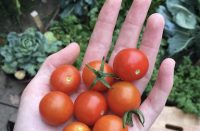Educational Video Companion: Indigenous Entrepreneurship and Housing Security
Environatives Training Initiative
Educational Video Companion: Indigenous Entrepreneurship and Housing Security
Environatives Training Initiative
Environatives Training Initiatives is a not-for-profit started by Becky Big Canoe which aims to design and deliver training programs for Indigenous women and youth that address food security, natural building skills and entrepreneurial skills. The goal is to provide culturally sensitive and targeted training in order to help lift people out of poverty, dependence, and vulnerability to harm. The food security and permaculture training offered by Environatives provides knowledge and skills to create community gardens, take produce to the market and start microbusinesses. Experts in the sustainable building industry deliver the natural building training, and the entrepreneur training is designed to be relevant to students and their local communities. These programs empower Indigenous women and youth by helping them find independence and overall well-being in their lives.
Indigenous Entrepreneurship in Canada
Basic assumptions of mainstream theories of entrepreneurship sometimes conflict with certain Indigenous cultural values. This is because the perception of opportunity is culturally relative, as is the measurement of success, both of which are important elements of entrepreneurship (Dana 2015). Indigenous entrepreneurship often incorporates community needs and objectives more holistically than Western forms of entrepreneurship.
Becky Big Canoe and many other Indigenous entrepreneurs, approach entrepreneurial activities with the desire to be environmentally sustainable. This comes from a strong connection to the land as its original inhabitants, which has been disrupted by colonization. As such, taking part in entrepreneurial enterprises offers a chance to reassert control over traditional territories and build community (Sengupta & Vieta, 2015). A significant amount of Indigenous entrepreneurial activity occurs outside the realm of traditional market exchanges. In the absence of market transactions, wealth can be generated by individuals and within the community without the sale of a good or service for profit. Regulatory barriers often prompt Indigenous entrepreneurs away from the traditional market setting. While there are multiple approaches to Indigenous entrepreneurship, it is often designed to be inclusive of economic, environmental, social and cultural goals, typically with a greater emphasis on cultural values than more non-Indigenous social enterprises (Sengupta & Vieta, 2015).
Canadian Indigenous Housing Security
Housing insecurity disproportionately affects the Indigenous population in Canada. The fact that Indigenous people are the fastest growing demographic in the Canadian population increases the challenges of supplying housing and puts greater pressure on band councils to do so.
According to 2016 census data, one in five Indigenous people in the country lived in a home in need of major repairs. Comparatively, in the same year, only six per cent of the non-Indigenous population reported living in a dwelling that required major repairs. In addition, those living on-reserve are more likely to live in the least adequate housing conditions, as people with registered Indian status who lived on reserve were 3 times more likely to need major housing repairs, with 44.% requiring repairs, compared to 14% for those living off-reserve.
On top of the issue of repairs, about one quarter of Indigenous people live in crowded housing. A higher proportion of Indigenous people with a registered Indian status lived in crowded housing than without (27 per cent versus 12 per cent). This proportion is even higher among those living on reserve than off (37 per cent versus 19 per cent).
Overcrowding can lead to a number of health and social issues. As Becky Big Canoe mentioned, mould is often found in poorly constructed and crowded houses, and poses health risks as a result. In some communities, there are so many people living in one house that they must sleep in shifts, revealed an interim report of the Standing Senate Committee on Aboriginal Peoples. This can disrupt a child’s focus in school, resulting in lower education achievement rates and lower employment rates. Overcrowding can also lead to homelessness.
Furthermore, a number of houses built on reserves are not constructed for the environment they’re situated in. Due to the costs of construction northern regions, many receive below-par construction. This is something Big Canoe directly addressed by building her own home from straw. There is also big problem with inadequate water infrastructure, resulting in drinking water advisories. Health Canada indicated that there were 100 long-term drinking water advisories and 47 short-term in 102 First Nations communities south of the 60th parallel as of Oct. 31, 2017. Boiling water for so many people can also contributes to mould growth, and thus worsen housing conditions.
***
To find out more about Becky Big Canoe’s non-profit Environatives Training initiatives, check out her website http://www.backtobasicscanada.com/environative-training
To find out more about the problem of inadequate housing for Indigenous peoples, see the following sources:
-
HOUSING ON FIRST NATION RESERVES: Challenges and Successes Interim Report of the Standing Senate Committee on Aboriginal Peoples, February 2015. https://sencanada.ca/content/sen/committee/412/appa/rms/08feb15/Home-e.htm
-
Statistics Canada. (2017). The housing conditions of Aboriginal people in Canada. Retrieved from https://www12.statcan.gc.ca/census-recensement/2016/as-sa/98-200-x/2016021/98-200-x2016021-eng.cfm
Syerra is currently an Environmental Visual Communications student with Fleming College and the Royal Ontario Museum. She holds a degree in journalism and sociology and hopes to explore new ways to effectively communicate today’s environmental issues.
Leah Gerber has always been pretty nosy. Sometimes she still has trouble distinguishing between being curious and being rude. She loves exploring Canada’s nooks and crannies, especially on a bicycle. Her goal is to tell stories, visually and with words, that inspire change in our world, even just a little.












